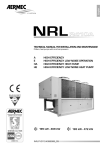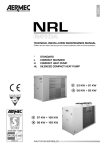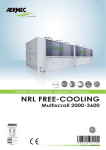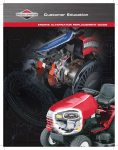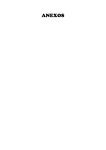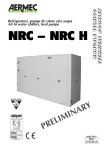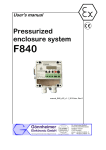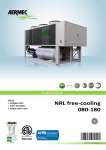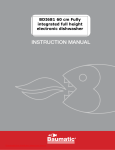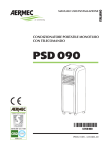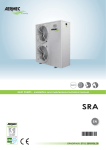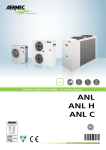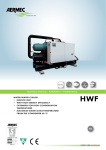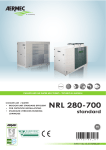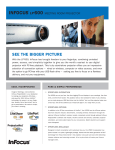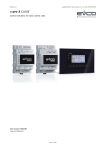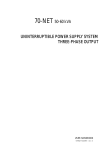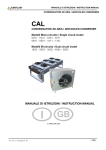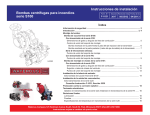Download Aermec NRL Free Cooling 750
Transcript
CHILLERS - Technical - installation - maintenance manual NRL free-cooling large scroll EN INRLFCPY. 0511. 4086911_04 Dear Customer, Thank you for choosing an AERMEC product. This product is the result of many years of experience and in-depth engineering research, and it is built using top quality materials and advanced technologies. Moreover, the CE mark guarantees that our appliances fully comply with the requirements of the European Machinery Directive in terms of safety. We constantly monitor the quality level of our products, and as a result AERMEC products are synonymous with Safety, Quality, and Reliability. Product data may be subject to modifications deemed necessary for improving the product without the obligation to give prior notice. Thank you again. AERMEC S.p.A AERMEC S.p.A. reserves the right at any moment to make any modifications considered necessary to improve our products and is not obliged to add these modifications to machines that have already been fabricated, delivered or are under construction. Summary 1. 1.1. 1.2. General warnings ........................................................ 6 Preservation of the documentation .......................... 6 Warnings regarding safety and installation standards ... 6 2. Description of the unit ................................................. 7 3. 3.1. Product identification ................................................. 7 Configurator ................................................................. 8 4. 4.1. 4.2. 4.3. 4.4. 4.5. 4.6. 4.7. Description of the components ................................. 9 Nrl 750 fc a/e................................................................ 9 Nrl 800 - 900 - 1000 fc a/e ........................................ 10 Cooling circuit............................................................ 11 Frame and fans.......................................................... 11 Hydraulic components ............................................. 11 Control and safety components ............................. 12 Electric components ................................................. 12 5. Accessories ................................................................ 13 6. 6.1. 6.2. Technical data .......................................................... 14 Chiller functioning technical data .......................... 14 Freecooling functioning technical data ................ 16 7. 7.1. 7.2. Operational limits....................................................... 18 Functioning in cooling mode ................................... 18 Project data ............................................................... 18 8. 8.1. Chiller functioning corrective factors...................... 18 Cooling capacity and input power ....................... 18 9. 9.1. 9.2. Free-cooling functioning corrective factors .......... 19 For ∆t different to nominal ........................................ 19 Deposit factors ........................................................... 19 10. 10.1. Glycol .......................................................................... 20 How to interpret glycol curves ................................. 20 11. 11.1. Pressure drops ............................................................ 21 Total pressure drops .................................................. 21 12. Useful static pressures ............................................... 22 13. 13.1. 13.2. 13.3. Storage ....................................................................... 23 Maximum/minimum water content in the system 23 Recommended minimum water content .............. 23 Maximum content on variation of the capacity of . the expansion vessel ................................................. 23 Water content in other functioning conditions with glycoled water .......................................................... 23 13.4. 14. Partialisations.............................................................. 24 15. 15.1. Desuperheater ........................................................... 24 Pressure drops ............................................................ 24 16. Sound data ................................................................ 25 17. Calibration of safety and control parameters ....... 26 18. Dimensions ................................................................. 27 19. 19.1. Dimension tables and hydraulic fitting positions.... 27 Percentage weight distribution on fc a-e supports ...38 20. Selection and place of installation ........................ 39 21. Positioning .................................................................. 39 22. 22.1. 22.2. 22.3. 22.4. Example of hydraulic circuits ................................... 40 External hydraulic circuit .......................................... 41 System loading .......................................................... 41 Emptying the system ................................................. 41 "Gr3" control board ................................................... 42 23. 23.1. 23.2. 23.3. 23.4. Electric connections ................................................. 43 Recommended electric cable section .................. 43 Connection to the power supply network ............. 43 Electric power connection....................................... 43 Auxiliary connections under the responsibility of the user/installer ............................................................... 43 24. 24.1. 24.2. 24.3. Control and commissioning ..................................... 45 Preparation for commissioning ................................ 45 Machine commissioning........................................... 45 Season changeover.................................................. 45 25. 25.1. 25.2. 25.3. 25.4. 25.5. 25.6. Functioning features ................................................. 46 Set point in cooling mode ........................................ 46 Set point in heating mode ....................................... 46 Compressor start-up delay ....................................... 46 Circulation pump ...................................................... 46 Anti-freeze alarm ....................................................... 46 Water flow rate alarm ............................................... 46 26. Routine maintenance ............................................... 46 27. Extraordinary maintenance ..................................... 46 28. R410a refrigerant gas ................................................ 47 AERMEC S.p.A. 37040 Bevilacqua (VR) Italy–Via Roma, 996 Tel. (+39) 0442 633111 Telefax 0442 93730–(+39) 0442 93566 www .aermec . com - info @ aermec. com NRL free-cooling SERIAL NUMBER EC DECLARATION OF CONFORMITY We, the undersigned, hereby declare under our own responsibility that the assembly in question, defined as follows: NAME NRL FREECOOLING TYPE AIR/WATER CHILLER MODELLO To which this declaration refers, complies with the following harmonised standards: CEI EN 60335-2-40 Safety standard regarding electrical heat pumps, air conditioners and dehumidifiers CEI EN 61000-6-1 CEI EN 61000-6-3 Immunity and electromagnetic emissions for residential environments CEI EN 61000-6-2 CEI EN 61000-6-4 Immunity and electromagnetic emissions for industrial environments EN378 Refrigerating systems and heat pumps - Safety and environmental requirements UNI EN 12735 UNI EN 14276 Seamless, round copper tubes for air conditioning and refrigeration Pressure equipment for cooling systems and heat pumps Therefore complying with the essential requirements of the following directives: - LVD Directive: 2006/95/CE - Directive for electromagnetic compatibility 2004/108/CE - Machinery Directive 2006/42/CE - PED Directive regarding pressurised devices 97/23/CE The product, in agreement with Directive 97/23/CE, satisfies the Total quality Guarantee procedure (form H) with certificate n.06/270-QT3664 Rev.5 issued by the notified body n.1131 CEC via Pisacane 46 Legnano (MI) Italy The person authorized to compile the technical file is: Massimiliano Sfragara - 37040 Bevilacqua (VR) Italy–Via Roma, 996 Bevilacqua 28/12/2009 Marketing Manager Firma 1. GENERAL WARNINGS Standards and Directives respected on designing and constructing the unit: Safety: Machinery Directive 2006/42/CE Low Voltage Directive LVD 2006/95/CE Electromagnetic compatibility Directive EMC 2004/108/CE Pressure Equipment Directive PED 97/23/CE EN 378, UNI EN 14276 Electric part: EN 60204-1 Protection rating IP24 Acoustic part: SOUND POWER (EN ISO 9614-2) SOUND PRESSURE (EN ISO 3744) Certifications: Eurovent Refrigerant GAS: This unit contains fluoride gases with greenhouse effect covered by the Kyoto Protocol. Maintenance and disposal must only be performed by qualified staff. R410A GWP=1900 AERMEC NRLs are constructed according to the recognised technical standards and safety regulations. They have been designed for air conditioning and the production of hot water and must be destined to this use compatibly with their performance features. Any contractual or extracontractual liability of the Company is excluded for injury/ damage to persons, animals or objects owing to installation, regulation and maintenance errors or improper use. All uses not expressly indicated in this manual are prohibited. the event of failure to comply with the above-mentioned indications. 1.1. − PRESERVATION OF THE DOCUMENTATION The instructions along with all the related documentation must be given to the user of the system, who assumes the responsibility to conserve the instructions so that they are always at hand in case of need. Read this sheet carefully; the execution of all works must be performed by qualified staff, according to Standards in force ion this subject in different countries. (Ministerial Decree 329/2004). The appliance must be installed in such a way as to enable maintenance and/ or repairs to be carried out. The appliance warranty does not cover the costs for ladder trucks, scaffolding, or other elevation systems that may become necessary for carrying out servicing under warranty. Do not modify or tamper with the chiller as dangerous situations can be created and the manufacturer will not be liable for any damage caused. The validity of the warranty shall be void in 1.2. − WARNINGS REGARDING SAFETY AND INSTALLATION STANDARDS The chiller must be installed by a qualified and suitably trained technician, in compliance with the national legislation in force in the country of destination (Ministerial Decree 329/2004). AERMEC will not assume any responsibility for damage due to failure to follow these instructions. Before beginning any operation, READ THESE INSTRUCTIONS CAREFULLY AND CARRY OUT THE SAFETY CHECKS TO PREVENT ALL RISKS OF DANGER. All the staff involved must have thorough knowledge of the operations and any dangers that may arise at the moment in which the installation operations are carried out. Danger! The refrigerant circuit is under pressure. Moreover, very high temperatures can be reached. The appliance may only be opened by a SAT service technician or by a qualified technician. Work on the cooling circuit may only be carried out by a qualified refrigeration technician. R410A REFRIGERANT GAS The chiller is delivered complete with the correct refrigerant load. R134A does not contain chlorine, is not inflammable and does not damage the ozone layer. However, any interventions are always the competence of the technical after/sales service (SAT) or a qualified technician. 6 INRLPY. 0511.4086911_03 2. − DESCRIPTION OF THE UNIT The appliances in the NRL F series are water chillers with cooling capacity recovery system of external air called “free-cooling”. The free water cooling system (from here the name free-cooling) consists integrating the cooling capacity distributed by the compressors up to total replacement via the use of an additional water coil, which makes use of the low temperature of the external air to cool the system return water. With this system, it is possible to obtain cooled water almost free of charge for all those installations where the constant production is requested and therefor also with low external air temperatures, e.g. industrial processes, shopping centres, hospitals and other civil applications. This type of solution allows to obtain a large energy saving: when the system return water is 2°C lower than the external air , a three-way valve diverts the water into the free-cooling coil to be pre-cooled and therefore sent to the evaporator where it is taken to the project temperature. The NRL free-cooling units are made up from two cooling circuits with R410A and a unique hydraulic circuit that can activate the freecooling water coil via the 3-way valve positioned in series with the plate evaporator. The hydraulic cir- 3. − − − − − − cuit can be supplied with storage tank unit or not. The presence of several scroll type compressors and the fan speed control via the revs, regulator device, allows the NRL chillers various partialisations of the cooling capacity both in compressors mode only and in free-cooling (partial or total). The electronic regulation with optimised micro processor for functioning with free-cooling controls and manages all components and unit functioning parameters; an internal memory records the functioning conditions when an alarm condition arises, to then show it on the display. The units have protection rating of IP 24. All of the various versions of appliances are supplied as per standard with: fans revs. number control device, evaporator anti-freeze electrical resistance, Compressor sump resistance, remote control panel, water filter, flow switch. FUNCTIONING MODE: − FREE-COOLING ONLY: when the external temperature is low enough to allow cooling of the water in the free-cooling coils to project temperature. It is the most economic way of using the unit. Only the fans work in speed modulation mode. − MIXED FREE-COOLING + COMPRESSORS: when the cooling capacity recovered from the external air is not longer sufficient to satisfy the power requested by the system, the compressors function in integration with free-cooling. The greater the power recovery with free-cooling the smaller this integration. − COMPRESSORS ONLY: when the external air temperature is greater than the return temperature of the system water. PRODUCT IDENTIFICATION NRL can be identified by: − Packing label reporting the identification data of the product. − Technical plate positioned on the lateral side-member of the electric box. NOTE: Tampering, removal, lack of the identification plate or other does not allow the safe identification of the product and will make any installation or maintenance operation to be performed difficult. TECHNICAL PLATE AE R M E C SP A - via R oma 44 37040 - B evilacqua (V R ) - I T AL I A M O D. ver s. P r od. date IP Serial no C A L DO HE A T C HA UD HE I ZUNG T S(H P /L P ) P t = kW F R E DDO C OL D F R OI D K UHL UNG P e = kW In = A Is = A C M in. M ax. R E S.E L /E L .HE AT E R R E S.E L /E -HE I ZUNG kW max = P f = kW P e = kW In = A Is = A P S (H P /L P ) bar R 407C Kg I n R x max = A I tot max = A NOTE: The drawings shown are only an example. INRLPY. 0511.4086911_03 7 3.1. CONFIGURATOR 1, 2, 3 4, 5, 6 7 8 9 10 11 12 13 14 15, 16 NRL 075 0 ° F ° A ° ° ° 00 Field 1, 2 ,3 Code NRL 4, 5, 6 Size 075, 080, 090, 100, 125, 140, 150, 165, 180 7 Compressors 0 Standard compressor 8 Thermostatic valve ° Standard mechanical thermostatic valve Y Mechanical thermostatic valve with water produced from +4°C to -6°C X Electronic thermostatic valve with water produced to -6°C 9 Model F 10 Heat recovery ° Without recuperators D Desuperheater 11 Version A E High efficiency High efficiency, silenced Coils ° R S V In aluminium In copper Tinned copper Painted aluminium (epoxy paint) Fans ° J Standard Inverter 12 13 8 Free-cooling 14 Power supply ° 400V-3N-50Hz with magnet-circuit breakers (750 only), 400V-3-50Hz (from 800 to 1800) 2 500V-3-50Hz with magnet circuit breakers 15, 16 Storage tank 00 03 04 P3 P4 INRLPY. 0511.4086911_03 Without hydronic storage tank Storage tank and high static pressure single pump Storage tank with high static pressure pump and reserve pump Without storage tank with high static pressure pump Without storage tank with high static head and reserve pump 4. DESCRIPTION OF THE COMPONENTS 4.1. NRL 750 FC A/E 4 6 5 8 9 7 11 12 13 3 2 1 10 14 NOTE: The drawings shown are only an example. KEY: 1 2 3 4 5 6 7 8 9 10 11 12 13 14 Storage tank Expansion vessel Pump Loading unit Safety valve Air vent valve Free-cooling and condensing coils Fans Electric box Compressors Filter Flow meter 3-way valves Evaporator INRLPY. 0511.4086911_03 9 4.2. NRL 800 - 900 - 1000 FC A/E 4 8 6 5 9 2 7 1 12 11 3 13 10 14 NOTE: The drawings shown are only an example. 1 2 3 4 5 6 7 8 9 10 11 12 13 14 10 Storage tank Expansion vessel Pump Loading unit Safety valve Air vent valve Free-cooling and condensing coils Fans Electric box Compressors Filter Flow meter 3-way valves Evaporator INRLPY. 0511.4086911_03 4.3. COOLING CIRCUIT Compressors High efficiency hermetic scroll compressors (on anti-vibration mounts), activated by a 2-pole electric motor with internal heat protection supplied as per standard of the sump resistance. The resistance is powered automatically when the unit stops as long as the unit is live. Air-side heat exchanger (condenser) High-efficiency, made with copper pipes and aluminium louvered fins blocked by mechanical expansion of the pipes. Refrigerant- water heat exchanger (evaporator) Unit with (AISI 316) heat plate, insulated externally with closed cell material to reduce heat loss. Supplied as per standard with the anti-freeze electric resistance. Dehydrator filter Mechanical dehydrator filter realised in ceramics and hygroscopic material, able to withhold impurities and any traces of humidity present in the cooling circuit. Liquid indicator Used to check the refrigerant gas load and the eventual presence of humidity in the cooling circuit. Liquid and pressing line taps Allows interruption of the refrigerant in the case of extraordinary maintenance. Solenoid valve The valve closes when the compressor switches off, blocking the flow of refrigerant gas towards the evaporator. Thermostatic valve Mechanical valve, with external equaliser positioned at evaporator outlet, modulates the flow of gas to the evaporator, depending on the heat load, in order to ensure a correct heating level of the intake gas. One-way valve Allows one-way flow of the refrigerant. 4.4. FRAME AND FANS Support frame Made in hot galvanised sheet steel with suitable thickness and painted with polyester powders able to resist atmospheric agents through time. 4.5. HYDRAULIC COMPONENTS Air-water exchanger (free-cooling) Passed through by water for functioning in free-cooling mode. IT IS realised with copper piping and aluminium louvres blocked via mechanical expansion of the pipes. (High-efficiency type. Circulation pump (pump only or with storage tank versions) Depending on the features of the pump chosen, it offers a useful static pressure to combat the system pressure drops. A reserve pump is also envisioned. The reserve pump is managed by the circuit board. Water filter (installed as per standard) This allows to block and eliminate any impurities present in the hydraulic circuits. It contains a filtering mesh with holes that do not exceed one millimetre. It is indispensable in order to prevent serious damage to the plate exchanger. 3-way valve Present on the water side of the freecooling circuit, it is an ON-OFF diverter valve controlled via electric servo-motor. Storage tank It is in steel with a capacity of 500 litres for the 750 size, from 800 to 1800 it is 700 litres. In order to reduce heat loss and eliminate the formation of condensate, it is insulated using thick polyurethane material. Mounted as per standard: - 1x300 W for the 750 - 2x300 W from 800 to 1800 (up to -20 °C external temperature - tank water temperature 5 °C) controlled by the board via an anti-freeze probe inserted in the tank. Air vent valve (all versions) Automatic, mounted on the upper part of the hydraulic plant, it discharges any air pockets present in the same. Loading unit (versions with storage tank) It is supplied with manometer for display of system pressure. Expansion vessel (versions with storage tank and pump only) With nitrogen pre-load membrane. Ventilation Unit Helical type, balanced statically and dynamically. The electric fans are protected electrically by magnet-circuit breakers and mechanically by anti-intrusion metal grids, according to the IEC EN 60335-2-40 Standard. INRLPY. 0511.4086911_03 11 4.6. CONTROL AND SAFETY COMPONENTS Flow switch (installed as per standard) Has the task of controlling that there is water in circulation. If this is not the case, the unit blocks. “AP” High pressure pressure switch(as per standard) With fixed calibration, placed on high pressure side of cooling circuit, inhibits functioning of compressor if abnormal work pressure occurs. “TP2” low pressure transducers (as per standard) Placed on low pressure side of cooling circuit, signals the work pressure to control board, generating a pre-warning in case abnormal pressure occurs. “TP3” High pressure transducer (as per standard) Placed on high pressure side of cooling circuit, signals the work pressure to control board, generating a pre-warning in case abnormal pressure occurs. Evaporator anti-freeze electrical resistance (installed as per standard) Its functioning is controlled by the antifreeze probe positioned in the plate evaporator. Activation takes place when the temperature of the water is +3°C while it is disconnected with water temperature of +5°C. The dedicated software, resident in the regulation board, manages the electric resistance. Cooling circuit safety valves They intervene by discharging the overpressure in the case of anomalous pressures. - Calibrated at 45 bar on the HP branch - Calibrated at 30 bar on the LP branch Hydraulic circuit safety valve (Only for versions complete with hydronic unit or with a pump) TCalibrated at 6 Bar and with piped discharger that discharges if abnormal work pressure occurs. 12 INRLPY. 0511.4086911_03 4.7. ELECTRIC COMPONENTS Electric Control Board Contains the power section and the management of controls and safety devices. It is in compliance with the Standards IEC EN 61000-6-1 IEC EN 61000-6-3 (immunity and electromagnetic emissions for residential environments). IEC EN 61000-6-2 IEC EN 61000-6-4 (immunity and electromagnetic emissions for industrial environments). With the EMC 89/336/EEC and 92/31/ EEC electro-magnetic compatibility Directives and the LVD 2006/95/CE Low Voltage Directive. Door-lock isolating switch The electric control board can be accessed by removing the voltage. Act on the opening lever of the control board itself. This lever can be locked using one or more padlocks during maintenance interventions to prevent the machine being powered up accidentally. Control board Allows the complete control of the appliance. For a more in-depth description please refer to the user manual. Remote control panel Allows to control the chiller at a distance. Compressors magnet circuit breaker protection; Fans magnet-circuit breakers protection; Auxiliary magnet circuit-breaker protection; Discharge gas temperature control thermostat. ELECTRONIC ADJUSTMENT Microprocessor board Made up of management, control and display boards. Functions carried out: evaporator inlet water temperature regulation with thermostating up to 4 steps and proportional – integral control of fan speeds; − − − − − − − − − • − − • − − − − − − − • − − − − − − − − • compressors start-up delays; compressors rotation sequence; compressors functioning hours count; start/stop; reset; permanent alarms memory; autostart after voltage drop; multilangauge messages; functioning with local or remote control. Machine condition display: compressors ON/OFF; alarms summary. Alarms management: high pressure; flow switch; low pressure; anti-freeze; compressors overload; fans overload; pumps overload. Display of the following parameters: water inlet temperature; storage tank temp.; water outlet temperature; delta T; high pressure; low pressure; re-start stand-by time; alarms display. Settings: a) without password: cold set; total differential; b) with password: anti-freeze set; low pressure exclusion time; display language; access code. For further information please refer to user manual. 5. ACCESSORIES 0750 AER485 A E • VT - AVX ( 00 ) A E VT 23 0800 0900 1000 1250 1400 1500 1650 1800 This accessory allows connection of the unit to BMS supervising systems with RS485 electric standard and MODBUS protocol. • • • • • • • • AVX 761 AVX 766 AVX 762 AVX 762 AVX 763 AVX 763 Rubber anti-vibration mounts. Select the model using the compatibility table. AVX 739 AVX 739 AVX 745 AVX 748 AVX 752 AVX 757 VT - AVX ( 03 - 04 ) Rubber anti-vibration mounts. Select the model using the compatibility table. A E VT 23 AVX 740 AVX 743 AVX 746 AVX 749 AVX 753 AVX 753 VT - AVX ( P3 - P4 ) Rubber anti-vibration mounts. Select the model using the compatibility table. A E VT 23 10 (x3) AVX 747 AVX 750 AVX 754 AVX 758 260 260 260 350 350 350 500 500 Small board to engage on the unit circuit board. Allows to program two time periods per day (two switchon/off cycles) and to have differentiated programming for every day of the week. PGS A E • DUALCHILLER A E • MULTICHILLER A E • AERWEB30 A E • • • • • • • • • Simplified control system for control, switch-on and switch-off of two chillers, with Aermec GR3 control, in the same plant as if they were the same unit. • • • • • • • • Control system for control, switch-on and switch-off of the single chillers in a plant in where multiple units are installed in parallel, always ensuring constant flow to the evaporators. • • • • • • • • AERWEB30: the AERWEB device allows remote control of a chiller from a common PC via serial connection. Using additional modules, the device allows to control the chiller via telephone network, using the AER-MODEM accessory; or GSM network, using the AERMODEMGSM accessory. The AERWEB can pilot up to 9 chillers, each of which must be equipped with the AER485 or AER485P2 accessory. • • • • • • • • Current rephaser. Connected in parallel to the motor, it allows a reduction of the input current. It can only be installed in the factory and so must be requested on ordering. RIF A E 53 DRE A E AVX 744 Protect the external coil from blows and prevent access to the area below where the compressors and the cooling circuit are housed. Every kit includes two grids. GP A E AVX 741 751 88 90 92 92 93 94 94 94 Allows the reduction of peak power supply necessary for the unit during start up phase. Accessory only applicable in the factory, only available power 400V 801 901 1001 1251 1401 1501 1651 1801 Reduction of the peak current with the accessory DRE MODEL Reduction of the peak current MONOCIRCUIT BICIRCUIT TRICIRCUIT QUADRICIRCUIT PENTACIRCUIt ESACIRCUIT -30% -26% -22% -20% -18% -16% INRLPY. 0511.4086911_03 13 6. TECHNICAL DATA 6.1. CHILLER FUNCTIONING TECHNICAL DATA COOLING Cooling capacity kW Total input power kW Water flow rate l/h Total pressure drops kPa A E A E A E A E 750 191 177 69,6 76,4 32850 30440 103 89 800 210 196 75 80 36120 33730 77 68 900 229 216 89 93 39390 37110 82 73 1000 247 228 103 109 42480 39210 81 69 1250 310 289 114 120 53320 49670 92 80 1400 337 310 136 145 57960 53260 98 84 1500 364 331 157 169 62610 56850 83 70 1650 430 400 159 169 73960 68770 104 90 1800 452 421 175 186 77740 72330 107 93 A E 2,75 2,32 2,80 2,45 2,57 2,32 2,40 2,09 2,72 2,41 2,48 2,14 2,32 1,96 2,70 2,37 2,58 2,26 ENERGETIC INDEX EER W/W ELECTRICAL DATA Power supply A Input current A Maximum current A Peak current A A E A E A E A E 400-3N-50 Hz 400-3-50 Hz 123 135 144 149 169 174 195 203 208 217 252 265 296 312 298 310 317 332 144 177 199 221 274 303 332 373 406 320 352 408 430 542 512 541 641 674 4/2 2/2 2/2 2/2 2/3 3/3 3/3 3/3 3/3 COMPRESSORS (SCROLL) Number/circuit n°/n° A E FANS (AXIAL) Quantity n° Air flow rate m³/h Input power kW Input current A Useful static pressure [1] Pa A E A E A E A E A E 3 4 4 4 6 6 6 8 8 56000 46500 79600 55700 78800 55200 78000 55800 115200 80600 114000 79800 112800 80700 155200 108600 153600 109800 5,25 7,0 7,0 7,0 10,5 10,5 10,5 13,9 13,9 11,3 14,8 14,8 14,8 22,2 22,2 22,2 29,6 29,6 177 200 218 231 208 220 203 221 241 262 223 250 225 255 194 216 185 208 3 4 4 4 6 6 6 8 8 56000 46500 79600 55700 78800 55200 78000 55800 115200 80600 114000 79800 112800 80700 155200 108600 153600 109800 2,5 7,0 7,0 7,0 10,5 10,5 10,5 13,9 13,9 3,9 14,8 14,8 14,8 22,2 22,2 22,2 29,6 29,6 70 49 48 47 46 45 44 46 46 4” 4” 4” 4” 2/25 2/25 2/25 2/25 FANS INVERTER (J) Quantity n° Air flow rate m³/h Input power kW Input current A Useful static pressure [1] Pa A E A E A E A E A E EVAPORATORS (HEAT PLATE) Quantity n° Hydraulic connections (in/out) Ø A E A E 1 2”1/2 3” 3” 3” 4” HYDRAULIC CIRCUIT Storage tank capacity Storage tank anti-freeze resistance Expansion vessel l W n°/l A E A E A E 500 700 1 x 300 2 x 300 2/25 2/25 * The hydraulic attachments are the Victalic type [1] The useful static pressures refer to the nominal air flow rate. 14 INRLPY. 0511.4086911_03 2/25 2/25 2/25 750 HIGH STATIC PRESSURE CIRCULATION PUMP A Input power KW 5,5 E A Input current A 11 E A 177 Useful static pressures KPa E 200 800 900 1000 1250 1400 1500 1650 1800 6,5 6,5 6,5 8,6 8,6 8,6 12,3 12,3 11,0 11,0 11,0 14,6 14,6 14,6 21,2 21,2 220 233 210 222 204 223 242 262 223 250 224 255 192 214 182 206 87 82 55 50 88,5 82,5 56,5 50,5 88,5 82,5 56,5 50,5 88,5 82,5 56,5 50,5 91,5 85,5 59,5 53,5 91 85 59,0 53,0 90,5 84,5 58,5 52,5 92 86 60,0 54,00 94 88 62,0 56,0 1955 2450 2450 2450 2450 2450 2450 2450 2450 1500 2200 2200 2200 2200 2200 2200 2200 2200 4350 3400 3400 3400 4250 4250 4250 5750 5750 1889 2460 2650 2840 3120 3380 3660 4220 4430 SOUND DATA Sound power (1) dBA Sound pressure (2) dBA A E A E DIMENSIONS Height mm Width mm Depth mm Empty weight Kg A E A E A E A E NOMINAL REFERENCE CONDITIONS IN COOLING MODE - Water input temperature - Outlet water temperature - External air temperature - ∆t 12 °C 7 °C 35 °C 5°C (1) SOUND POWER Aermec determines sound power values in agreement with the 9614-2 standard, in compliance with that requested by Eurovent certification. (2) SOUND PRESSURE Sound pressure measured in free field conditions with reflective surface (directivity factor Q=2) at 10mt distance from external surface of unit, in compliance with ISO 3744 regulations. INRLPY. 0511.4086911_03 15 6.2. FREECOOLING FUNCTIONING TECHNICAL DATA COOLING 750 Cooling capacity kW Total input power kW Water flow rate l/h Total pressure drops kPa A E A E A E A E 187 5,4 32850 30440 156,3 134 800 182 178 7,5 7,5 36120 33730 105 93 900 206 201 7,5 7,5 39390 37110 110 99 1000 229 223 7,5 7,5 42840 39210 110 94 1250 257 263 11,0 11,0 53320 49670 123 106 1400 291 288 11,0 11,0 57960 53260 131 110 1500 326 314 11,0 11,0 62610 56850 117 94 1650 399 396 14,5 14,5 73960 68770 140 117 1800 440 443 14,5 14,5 77740 72330 145 120 24,30 23,76 27,48 26,76 30,53 29,76 23,34 23,89 26,47 26,19 29,61 28,50 27,48 27,33 30,32 30,58 ENERGETIC INDEX EER W/W A E 34,63 ELECTRICAL DATA Power supply A Input current A Maximum current A Peak current A A E A E A E A E 400-3N-50 Hz 400-3-50 Hz 11,6 15 15 15 22 22 22 30 30 144 177 199 221 274 303 332 373 406 320 352 408 430 542 512 541 641 674 4/2 4/2 4/2 4/2 5/2 6/2 6/2 6/2 6/2 3 4 4 4 6 6 6 8 8 56000 46500 79600 55700 78800 55200 78000 55800 115200 80600 114000 79800 112800 80700 155200 108600 153600 109800 5,25 7,0 7,0 7,0 10,5 10,5 10,5 13,9 13,9 11,3 14,8 14,8 14,8 22,2 22,2 22,2 29,6 29,6 119 150 196 212 187 202 181 203 222 245 204 234 208 242 173 197 164 189 4” 4” 4” 4” 2/25 2/25 2/25 COMPRESSORS (SCROLL) Number/circuit n°/n° A E / FANS (AXIAL) Quantity n° Air flow rate m³/h Input power kW Input current A Useful static pressure [1] Pa A E A E A E A E A E EVAPORATORS (HEAT PLATE) Quantity n° [*]Hydraulic connections (in/out) Ø A E A E 1 2”1/2 3” 3” 3” 4” HYDRAULIC CIRCUIT Storage tank capacity l Storage tank anti-freeze resistance W Expansion vessel n°/l A E A E A E 500 700 1 x 300 2 x 300 2/25 [*] The hydraulic attachments are the Victalic type [1] The useful static pressures refer to the nominal air flow rate. 16 INRLPY. 0511.4086911_03 2/25 2/25 2/25 2/25 2/25 750 HIGH STATIC PRESSURE CIRCULATION PUMP A Input power KW 5,5 E A Input current A 11 E A 119 Useful static pressures KPa E 150 800 900 1000 1250 1400 1500 1650 1800 6,5 6,5 6,5 8,6 8,6 8,6 12,3 12,3 11,0 11,0 11,0 14,6 14,6 14,6 21,2 21,2 194 211 184 202 177 203 214 245 195 234 195 242 165 197 155 189 87 82 55 50 88,5 82,5 56,5 50,5 88,5 82,5 56,5 50,5 88,5 82,5 56,5 50,5 91,5 85,5 59,5 53,5 91 85 59,0 53,0 90,5 84,5 58,5 52,5 92 86 60,0 54,00 94 88 62,0 56,0 1955 2450 2450 2450 2450 2450 2450 2450 2450 1500 2200 2200 2200 2200 2200 2200 2200 2200 4350 3400 3400 3400 4250 4250 4250 5750 5750 1889 2470 2650 2840 3120 3380 3660 4220 4420 SOUND DATA Sound power (1) dBA Sound pressure (2) dBA A E A E DIMENSIONS Height mm Width mm Depth mm Empty weight Kg A E A E A E A E PC NOMINAL REFERENCE CONDITIONS IN COOLING MODE - Water input temperature - External air temperature - Nominal water flow rate - Compressors off 15 °C 2 °C (1) SOUND POWER Aermec determines sound power values in agreement with the 9614-2 standard, in compliance with that requested by Eurovent certification. (2) SOUND PRESSURE Sound pressure measured in free field conditions with reflective surface (directivity factor Q=2) at 10mt distance from external surface of unit, in compliance with ISO 3744 regulations. INRLPY. 0511.4086911_03 17 OPERATIONAL LIMITS The units, in standard configuration, are not suitable for installation in salty environments . For functioning limits, please refer to the diagram 7.1, valid for ∆t = 5°C. NOTE Whenever the unit must function outside the operational limits, we recommend contacting our technical-sales dept. first. If the unit is installed in particularly windy areas, a windbreak should be provided to prevent malfunctioning of the DCPX 7.1. FUNCTIONING IN COOLING MODE 46 45 40 External air temperature d.b. °C 7. 35 30 25 Functioning with glycol Standard Functioning Functioning with glycol and with the DCPX accessory Functioning with DCPX accessory 20 15 10 5 0 -5 -10 -15 -5 0 5 10 15 18 Temperature of the water produced °C 7.2. PROJECT DATA COOLING Acceptable maximum pressure Acceptable maximum temperature Acceptable minimum temperature 8. CHILLER FUNCTIONING CORRECTIVE FACTORS 8.1. COOLING CAPACITY AND INPUT POWER High Pressure Low Pressure side 42 120 -16 side 25 52 -16 bar °C °C CHILLER FUNCTIONING COOLING CAPACITY CORRECTIVE COEFFICIENTSCHILLER 20°C 1,6 25°C 1,5 KEY: Cf: 35°C 1,3 1,2 1,1 Cf The cooling capacity efficiency and electrical input power in conditions differing from normal conditions are obtained by multiplying the nominal values (Pf, Pa) by the respective coefficient correctives (Cf, Ca). The following diagrams show how to obtain corrective coefficients to use for units in their various versions in cooling mode; external air temperature, to which reference is made, is shown in correspondence to each curve. 30°C 1,4 "HIGH EFFICIENCY VERSIONS" 40°C 1 0,9 44°C 0,8 0,7 0,6 0,5 0,4 -6 -4 -2 0 2 4 6 8 10 12 14 16 18 Water produced (°C) CHILLER FUNCTIONING COOLING MODE INPUT POWER CORRECTIVE COEFFICIENTS 1,4 Corrective co-efficient of the cooling capacity. 1,3 FOR ∆t DIFFERENT FROM 5°C At the evaporator use Tab. 9.2.1. to obtain correction factors of cooling power and input power. To consider dirtiness of the exchangers, use the relative deposit factors Tab. 9.2.2. Ca cold Corrective co-efficient of the Input power. 40°C 35°C 30°C 1,1 25°C 1 20°C 0,9 0,8 0,7 0,6 -6 -4 -2 0 2 4 6 8 Water produced (°C) 18 INRLPY. 0511.4086911_03 10 12 14 16 18 External air temperature 44°C 1,2 Ca: External air temperature − FREE-COOLING FUNCTIONING CORRECTIVE FACTORS FREE-COOLING ONLY FUNCTIONING COOLING CAPACITY CORRECTIVE COEFFICIENTS 4,00 -20°C 3,50 -15°C 3,00 -10°C 2,50 -5°C 2,00 0°C 5°C 1,50 10°C 1,00 15°C External air temperature The maximum cooling capacity yielded when functioning is completely in free-cooling mode, i.e. all compressors are off, is obtained by multiplying the cooling capacity nominal value (Pf) given in the Technical Data by the respective corrective coefficient, which is obtained from the following diagram on the basis of the temperature of the water produced and the temperature of the external air. These values refer to the fans in full rev conditions (maximum input power). If the power yielded should result in excess, a modulation will intervene on the number of revs. Free-cooling corrective coefficient (Pf) 9. 0,50 0,00 -10 -8 -6 -4 -2 0 2 4 6 8 10 12 14 16 18 20 22 24 26 28 Temperature of the system return water 9.1. FOR ∆T DIFFERENT TO NOMINAL For ∆t different from 5°C at evaporator use Tab. 9.2.1. to obtain correction factors of cooling power and input power. To be able to consider exchanger uncleanliness, relative dirtying factors are used Tab. 9.2.2. 9.2. 9.2.1. ∆t different to nominal Cooling capacity correction factors Input power correction factors 3 0,99 0,99 9.2.2. Deposit factors [K*m2]/[W] Cooling capacity correction factors Input power correction factors 0,00005 1 1 5 1 1 8 1,02 1,01 10 1,03 1,02 DEPOSIT FACTORS The performances shown by the table refer to clean tubes with deposit factor=1. For different deposit factors multiply the data in the performance tables by the coefficients given. 0,0001 0,98 0,98 0,0002 0,94 0,95 INRLPY. 0511.4086911_03 19 10. GLYCOL − HOW TO INTERPRET GLYCOL CURVES The curves shown in the diagram summarise a significant number of data, each of which is represented by a specific curve. In order to use these curves correctly it is first necessary to make some initial reflections. − − 20 If you wish to calculate the percentage of glycol on the basis of the external air temperature, enter from the left axis and on reaching the curve draw a vertical line, which in turn will intercept all the other curves; the points obtained from the upper curves represent the coefficients for the correction of the cooling capacity and input power, the flow rates and the pressure drops (remember that these coefficients must be multiplied by the nominal value of the size in question); while the glycol percentage value recommended to produce desired water temperature is on the lower axis. If you wish to calculate the percentage of glycol on the basis of the temperature of the water produced, enter from the right axis and on reaching the curve draw a vertical line, which in turn will intercept all the other curves; the points obtained from the upper curves INRLPY. 0511.4086911_03 FcGDpF (a) 2.10 FcGDpF (b) FcGDpF (c) 1.90 FcGDpF (d) 1.80 1.70 1.60 FcGDpF (e) 1.50 1.390 1.40 1.30 1.310 1.20 1.180 1.10 1.00 1.090 FcGQF 1.280 FcGQ (PdC) 1.110 FcGPf (PdC) 1.000 0.99 0.990 0.98 FcGPa 0.975 0.97 0.96 0.95 FcGPf 0.94 5 0 5 -5 -10 -6 0 -3 -15 -20 -25 -30 -35 -40 0 5 10 15 20 25 30 35 40 45 50 55 %Glicole LEGENDA: FcGPf FcGPa FcGDpF (a) FcGDpF (b) FcGDpF (c) FcGDpF (d) FcGDpF (e) FcGQF FcGQC Temperature of the water produced 10.1. 2.20 2.00 External air temperature The correction factors of cooling power and input power take into account the presence of glycol and diverse evaporation temperatures. − The pressure drop correction factor considers the different flow rate resulting from the application of the water flow rate correction factor. − The water flow rate correction factor is calculated to keep the same ∆t that would be present with the absence of glycol. NOTE On the following page an example is given to help graph reading. to determine the percentage of glycol required, see below diagram; this percentage calculation can take into consideration one of the following factors: Depending on which fluid is considered (water or air), the graph is interpreted by the right or left side at the crossing point on the curves with the external temperature line or the water produced line. A point from which the vertical line will pass is obtained and this will distinguish both glycol percentage and relative correction coefficients. Corrective factors for cooling capacity Corrective factors of the input power Correction factors for pressure drop (evaporator) (av. temp. = -3.5 °C) Correction factors for pressure drops (av. temp. = 0.5 °C) Correction factors for pressure drops (av. temp. = 5.5 °C) Correction factors for pressure drops (av. temp. = 9.5 °C) Correction factors for pressure drops (av. temp. = 47.5 °C) Correction factor of flow rates (evap.) (av. temp. = 9.5 °C) Correction factors of flow rates (condenser) (av. temp. = 47.5 °C) NOTE Although graph shows up to external air temperature of -40°C, unit operational limits must be considered. − represent the coefficients for the correction of the cooling capacity and input power, the flow rates and the pressure drops (remember that these coefficients must be multiplied by the nominal value of the size in question); while the lower axis recommends the glycol percentage value necessary to produce water at the desired temperature. Initial rates for “EXTERNAL AIR TEMPERATURE” and “TEMPERATURE OF PRODUCED WATER”, are not directly related, therefore it is not possible to refer to the curve of one of these rates to obtain corresponding point on the curve of the other rate.on the curve of the other rate. 11. PRESSURE DROPS 11.1. TOTAL PRESSURE DROPS NOTE: The pressure drops reported here are relative to functioning in “Chiller” and “Free-Cooling” modes, both calculated with an average temperature of the water at 10°C. CHILLER FUNCTIONING PRESSURE DROPS 350 750 Total pressure drops [kPa] 300 250 1250 900 1000 800 200 1650 1800 1400 1500 150 100 50 0 0 10000 20000 30000 40000 50000 60000 70000 80000 90000 100000 110000 120000 130000 Water flow rate [l/h] FREE-COOLING FUNCTIONING PRESSURE DROPS 450 750 400 Total pressure drops [kPa] 350 1650 300 1250 900 800 1800 1400 1500 1000 250 200 150 100 50 0 0 10000 20000 30000 40000 50000 60000 70000 80000 90000 100000 110000 120000 1300000 Water flow rate [l/h] Average water temperature [°C] Multiplicative coefficients 5 1,02 10 1 15 0,985 20 0,97 30 0,95 40 0,93 50 0,91 INRLPY. 0511.4086911_03 21 12. USEFUL STATIC PRESSURES NRL chiller function useful static pressures 400 350 Pressure drops (kPa) 300 250 200 1800 1650 150 100 50 0 20000 80 75 0 0 30000 40000 50000 12 90 100 0 0 60000 50 70000 150 14 0 00 80000 90000 100000 Water flow rate [l/h] NRL free-cooling function useful static pressures 400 350 Pressure drops (kPa) 300 250 200 150 180 0 1650 100 75 0 50 0 20000 30000 40000 80 0 50000 90 100 0 0 60000 Water flow rate [l/h] 22 INRLPY. 0511.4086911_03 12 50 70000 14 00 80000 15 00 90000 100000 13.1. MAXIMUM/MINIMUM WATER CONTENT IN THE SYSTEM 13.1.1. Recommended maximum water content Table 13.3 indicates maximum water capacity in litres of hydraulic plant, compatible with expansion vessel. The values shown in the table refer to three maximum and minimum water temperatures. If the effective water content of the hydraulic plant (including the storage tank, if present) is greater than that given in the table at operational conditions, another dimensioned expansion vessel must be installed, using the normal criteria, with reference to the additional volume of water. In tables 13.4 it is possible to work out the maximum values of the system also for glycoled water function. Values are worked out by multiplying the referred value by the corrective coefficient. 13.1.2. Expansion vessel calibration Standard pre-load pressure value of expansion vessel when empty is 1.5 bar, while their volume is 25 litres, maximum value is 6 bar. Calibration of the vessel must be regulated using the maximum level difference (H) of the user (see diagram) by using the following formula: p (calibration) [bar] = H [m] / 10.2 + 0.3. For example: if level difference (H) is equal to 20m, the calibration value of the vessel will be 2.3 bar. If calibration value obtained from formula is less than 1.5 bar (that is for H < 12.25), keep calibration as standard. NRL FC MAXIMUM CONTENT ON VARIATION OF THE CAPACITY OF THE EXPANSION VESSEL Hydraulic height Hm 30 25 20 15 Calibration of expansion vessel bar 3.2 2.8 2.3 1.8 1.5 Recommended values of water content. l (1) 2.174 2.646 3.118 3590 3852 Recommended values of water content. l (2) 978 1190 1404 1616 1732 Recommended values of water content. l (3) 510 622 732 844 904 13.4. WATER CONTENT IN OTHER FUNCTIONING CONDITIONS WITH GLYCOLED WATER Glycoled water Corrective coefficients Recommended conditions 40 -2 0,507 (1) 60 -2 0,686 (2) 10% 85 -2 0,809 (3) 20% 40 -6 0,434 (1) 20% 60 -6 0,604 (2) 20% 85 -6 0,729 (3) 35% 40 -6 0,393 (1) 35% 60 -6 0,555 (2) 35% 85 -6 0,677 (3) Recommended operational conditions: (1) Cooling: Max water temp. = 40 °C, min water temp. = 4 °C. (2) Heating (hot air pump): Max water temp. = 60 °C, min water temp. = 4 °C. (3) Heating (boiler): Max water temp. = 85 °C, min water temp. = 4 °C. H max (1) = 55 m H = 12.25 m RECOMMENDED MINIMUM WATER CONTENT H H=0m Compressor n° (1) l/KW (2) l/KW 4 4 8 1000 1250 5 4 8 6 4 8 1500 1650 min. 10% 0800 1400 Water temp. °C max. 10% 0750 0900 ≥ 12.25 Ptar = 1.5 bar 13.2. 13.3. Ptar = H / 10.2 + 0.3 STORAGE Ptar = 1.5 bar 13. H min (2) KEY (1) Check that highest installation is not higher than 55 metres. (2) Ensure that lowest installation can withstand global pressure in that position. 1800 (1) Minimum water content Minimum water content in the case of application of process or functioning with low external temperatures and low load (2) Regulation on the outlet water temperature project ∆t less than 5°C. INRLPY. 0511.4086911_03 23 14. PARTIALISATIONS [❄] % Cooling capacity Power steps Versions 1° 2° 3° 4° 5° 6° NRL 750 27 53 77 100 - - NRL 800 27 53 77 100 - - NRL 900 27 53 77 100 - - NRL 1000 27 53 77 100 - - NRL 1250 27 53 77 100 - - NRL 1400 23 44 63 82 100 - NRL 1500 19 37 55 71 86 100 NRL 1650 19 37 55 71 86 100 NRL 1800 19 37 55 71 86 100 [❄] % input power Power steps Versions 1° 2° 3° 4° 5° 6° NRL 750 23 47 73 100 - - NRL 800 23 47 73 100 - - NRL 900 23 47 73 100 - - NRL 1000 23 47 73 100 - - NRL 1250 23 47 73 100 - - NRL 1400 18 37 56 77 100 - NRL 1500 14 29 46 63 81 100 NRL 1650 14 29 46 63 81 100 NRL 1800 14 29 46 63 81 100 KEY: The performance refers to the following conditions: ❄ ❄ Temperature of water produced: 7°C External air temperature: 35°C 15. DESUPERHEATER The heating capacity obtained by the desuperheater is attained by multiplying the nominal value (Pd), given in table 15.1.1, by a relevant coefficient (Cd). The following diagrams show how to obtain corrective coefficients to use for units in their various versions in cooling mode; external air temperature, to which reference is made, is shown in correspondence to each curve. In eat pump models the desuperheater must be shut-off in heat pump mode, or the warranty will be come null and void. Average water temperature °C Multiplicative coefficient 24 INRLPY. 0511.4086911_03 30 1.04 15.1. PRESSURE DROPS The NRL models with desuperheater have 2 desuperheaters (placed in parallel). NOTE: The features of the desuperheaters and the pressure drop curves are given below. For temperature of produced water values, different from 50°C, multiply by corrective factor shown in figure 15.1.1. Nominal value referring to: −Air temperature 35°C −Water to the desuperheater 45/50°C −∆t 5°C 40 1.02 50 1 60 0.98 70 0.96 table 15.1.1 DESUPERHEATER CORRECTIVE COEFFICIENTS 3.00 Corrective coefficient Cd 2.50 2.00 1.50 1.00 45°C 40°C 0.50 35°C 30°C 20°C 25°C 0.00 35 40 45 50 55 60 65 Temperature of water produced at the desuperheater ∆t 5°(°C) DESUPERHEATER PRESSURE DROPS 100 1500 - 1800 90 Pressure drops (kPa) 80 1400 - 1650 70 750 60 50 1250 40 900 - 1000 30 800 20 10 0 0 10.000 20.000 30.000 40.000 50.000 60.000 Water capacity l/h 16.1.1. NRL (D) 750 800 900 1000 1250 1400 1500 1650 1800 kW 69,0 74,3 84,8 95,4 110,9 126,7 142,6 155,1 167,7 Desuperheater water flow rate l/h 11870 12790 14590 16400 19070 21800 24520 26680 28840 Desuperheater pressure drop kPa 21,0 9,0 9,6 12,5 15,5 16,5 22,5 24,3 30,9 Heating capacity recovered 16. SOUND DATA NRL A-FC Sound power Aermec determines sound power values in agreement with the 9614-2 standard, in compliance with that requested by Eurovent certification. Sound Pressure Sound pressure measured in free field conditions with reflective surface (directivity factor Q=2) in compliance with ISO 3744 regulations. NOTE: The data is relative to the version with standard fans. 0750A 0800A 0900A 1000A 1250A 1400A 1500A 1650A 1800A Total sound levels Pressure Pow. dB(A) dB(A) dB(A) 10 m 1m 87,0 55,0 69,0 88,5 56,5 70,0 88,5 56,5 70,0 88,5 56,5 70,0 91,5 59,5 73,0 91,0 59,0 72,5 90,5 58,5 72,0 92,0 60,0 73,5 94,0 62,0 75,5 125 73,9 99,5 99,5 98,0 99,2 101,0 102,0 101,0 102,0 Octave band [Hz] 250 500 1000 2000 4000 Sound potential for centre of band [dB] frequency (A) 75,9 79,3 81,6 82,7 76,5 87,5 84,5 83,0 76,5 72,0 87,5 84,5 83,0 76,5 72,0 87,0 84,8 82,9 79,1 75,1 93,5 87,5 85,5 82,2 76,0 90,0 86,0 87,0 79,0 71,0 89,0 86,0 85,0 79,0 71,5 92,5 88,5 87,0 81,0 73,0 95,0 90,5 89,5 82,0 73,0 8000 63,4 64,0 64,0 67,0 65,2 64,0 65,0 66,0 67,0 INRLPY. 0511.4086911_03 25 Values referring to: − − − Water input temperature 12°C Temperature of produced water 7°C 35°C External air temperature 17. Total sound levels Pressure NRL E-FC Pow. dB(A) dB(A) dB(A) 10 m 1m 0750E 82,0 50,0 64,0 0800E 82,5 50,5 64,0 0900E 82,5 50,5 64,0 1000E 82,5 50,5 64,0 1250E 85,5 53,5 67,0 1400E 85,0 53,0 66,5 1500E 84,5 52,5 66,0 1650E 86,0 54,0 67,5 1800E 88,0 56,0 69,5 Octave band [Hz] 250 500 1000 2000 4000 Sound potential for centre of band [dB] frequency (A) 74,5 74,9 72,1 77,3 71,1 79,5 76,5 75,0 68,5 64,5 79,5 76,5 75,0 68,5 64,5 79,5 76,5 75,0 68,5 64,5 87,5 80,0 79,0 76,5 69,5 82,5 80,0 79,0 72,5 63,5 81,5 78,5 75,5 71,5 62,5 83,5 79,0 79,5 76,5 66,5 87,0 81,3 82,5 78,0 68,5 125 72,3 96,0 96,0 96,0 95,0 97,5 98,5 98,5 99,5 8000 67,8 58,5 58,5 58,5 61,5 57,5 56,5 61,5 62,9 CALIBRATION OF SAFETY AND CONTROL PARAMETERS CONTROL PARAMETERS Cooling set Anti-freeze intervention Total differential Inlet temperature of the water in cooling functioning mode. MIN. MAX. DEFAULT -10°C 20°C 7.0°C Anti-freeze alarm intervention temperature on EV side (water outlet temperature). MIN. MAX. DEFAULT -15°C 4°C 3°C Temperature proportional and within which the compressors are activated and deactivated. MIN. MAX. DEFAULT 3°C 10°C 5°C Autostart NRL 750 800 900 1000 1250 1400 1500 1650 1800 400V COMPRESSORS MAGNET-CIRCUIT BREAKERS MTC 1 MTC 1A MTC 1B MTC 2 MTC 2A MTC 2B 29A 29A 29A 29A - 40A 40A 40A 40A - 40A 40A 51A 51A - 51A 51A 51A 51A - 62A 62A 62A 62A - 62A 62A 51A 51A 51A 51A 51A 51A 51A 51A 51A 51A 51A 51A 62A 62A 62A 62A 62A 62A 62A 62A 62A MANUAL REARM HIGH PRESSURE PRESSURE SWITCH PA (bar) 40 40 40 40 40 40 40 40 40 HIGH PRESSURE TRANSDUCER TAP (bar) 50 LOW PRESSURE TRANSDUCER TBP (bar) 30 COOLING CIRCUIT SAFETY VALVES AP (bar) LP (bar) heat pump only MAGNETOTERMICI VENTILATORI N° fans A N° fans E Note: The PS maximum pressure water side is 6 bar. 26 Auto INRLPY. 0511.4086911_03 45 30 45 30 45 30 45 30 45 30 45 30 45 30 45 30 45 30 3 4 4 4 6 6 6 8 8 18. DIMENSIONS MOD. VERSIONS A (mm) B (mm) C (mm) 0750 A-E 4350 1500 1955 0800 A-E 3400 2200 2450 0900 A-E 3400 2200 2450 1000 A-E 3400 2200 2450 1250 A-E 4250 2200 2450 1400 A-E 4250 2200 2450 1500 A-E 4250 2200 2450 1650 A-E 5750 2200 2450 1800 A-E 5750 2200 2450 C C B A Size 0750 B A Size 0800 - 1800 The drawings shown are only an example of the machine. 19. DIMENSION TABLES AND HYDRAULIC FITTING POSITIONS 19.1.1. NRL 750 FC A/E Vitaulic Connections Attacchi Vitaulic To the system All’impianto 504 182 438 Ritorno impianto System Return 303 Foro perfor scarico serbatoio Hole tank draining 711 720 Quotesriferite referring the base Quote dal to basamento ATTENTION The hydraulic attachments are the Victalic type Aux. B view Scale: 1:10 INRLPY. 0511.4086911_03 27 1392 50 50 100 1500 Hole for electrical power supply 1150 1500 100 DN80 Victaulic connection ATTENTION The hydraulic attachments are the Victalic type 28 INRLPY. 0511.4086911_03 240 2191 2450 19.1.2. NRL 800 - 900 -1000 FC A / E IN 4” 1500 1400 OUT 3” 2800 1400 100 100 2000 2100 100 100 100 341 100 Hole for electrical power supply 2800 100 2200 100 3400 ATTENTION The hydraulic attachments are the Victalic type INRLPY. 0511.4086911_03 29 19.1.3. NRL 1250 - 1400 - 1500 FC A / E 1825 1825 100 2100 2000 100 50 100 100 50 Hole for electrical power supply 1825 100 2191 1825 240 2450 100 341 1925 3850 IN 4” 400 2200 OUT 4” 4250 ATTENTION The hydraulic attachments are the Victalic type 30 INRLPY. 0511.4086911_03 1915 720 1915 400 2100 400 50 100 2000 50 100 19.1.4. NRL 1650 - 1800 FC A/E 1915 720 1915 400 240 280 2450 2191 400 265 2675 5350 IN 4” 400 2200 OUT 4” 5750 ATTENTION The hydraulic attachments are the Victalic type INRLPY. 0511.4086911_03 31 19.1.6. NRL 800 - 900 - 1000 [P3 - P4] FC A/E 100 2800 1400 1400 100 100 2800 100 2450 2190 100 2000 2100 100 100 100 420 240 IN 4” OUT 4” 1300 1500 400 2200 3000 3400 32 INRLPY. 0511.4086911_03 ATTENTION The hydraulic attachments are the Victalic type 2450 2190 19.1.7. NRL 1250 - 1400 - 1500 [P3 - P4]FC A/E 424 280 IN 4” 1727 1927 OUT 4” 400 3850 1825 100 1825 1825 100 2100 1825 100 2200 100 2000 100 100 4250 ATTENTION The hydraulic attachments are the Victalic type INRLPY. 0511.4086911_03 33 2190 2450 19.1.8. NRL 1650-1800 [P3 - P4] FC A/E 420 280 IN 4” 2535 2675 400 5350 4” 400 1915 720 1915 400 400 1915 720 1915 400 2200 100 2000 2100 100 OUT 4” 5750 ATTENTION The hydraulic attachments are the Victalic type 34 INRLPY. 0511.4086911_03 100 2800 100 2800 100 100 OUT4”4” 420 240 2450 2190 100 2800 2100 100 19.1.9. NRL 800-900-1000 [03-04] FC A/E IN 4” 1300 400 2200 300 3400 ATTENTION The hydraulic attachments are the Victalic type INRLPY. 0511.4086911_03 35 19.1.10. NRL 1250-1400-1500 [03-04] FC A/E OUT 4” IN 4” ATTENTION The hydraulic attachments are the Victalic type 36 INRLPY. 0511.4086911_03 19.1.11. NRL1650-1800 [03-04] FC A/E OUT 4” IN 4” ATTENTION The hydraulic attachments are the Victalic type INRLPY. 0511.4086911_03 37 19.1. PERCENTAGE WEIGHT DISTRIBUTION ON FC A-E SUPPORTS 1 3 5 7 6 8 G Gy 2 4 Gx A VACUUM WEIGHT CENTRE OF GRAVITY (Kg) Xg Yg MODEL 38 RUNNING TOTAL WEIGHT Kg PERCENTAGE OF WEIGHT DISTRIBUTION SUPPORTS (%) CENTRE OF GRAVITY Water Xg Yg 1 2 3 4 5 6 7 8 VT AVX KIT NRL 750 F A/E 00 1889 2024 773 1920 31 2027 766 9% 9% 13% 13% 25% 26% 3% 3% VT 23 NRL 750 F A/E 03 2079 2116 771 2670 531 2169 761 7% 7% 12% 13% 28% 29% 2% 2% VT 23 NRL 750 F A/E 04 2139 2083 771 2610 531 2144 762 7% 7% 13% 13% 28% 29% 2% 2% VT 23 NRL 750 F A/E P3 1949 2098 772 2040 31 2100 765 8% 9% 12% 12% 26% 27% 3% 3% VT 23 NRL 750 F A/E NRL 800 F A/E NRL 800 F A/E NRL 800 F A/E NRL 800 F A/E NRL 800 F A/E NRL 900 F A/E NRL 900 F A/E P4 00 03 04 P3 P4 00 03 2009 2470 2820 2890 2650 2700 2650 3000 2062 1399 1377 1373 1360 1349 1434 1409 773 854 971 991 916 933 868 977 1980 2610 3690 3760 2870 2920 2810 3890 31 140 870 870 220 220 160 890 2065 1425 1365 1362 1368 1358 1456 1391 765 867 1140 1152 952 966 887 1140 9% 10,7% 16,0% 16,3% 12,6% 13,0% 10,4% 15,4% 9% 16,5% 14,9% 14,8% 16,6% 16,6% 15,4% 14,3% 12% 20,1% 24,8% 25,0% 22,0% 22,4% 20,8% 25,1% 13% 30,9% 23,0% 22,7% 28,9% 28,6% 30,8% 23,3% 26% 8,6% 11,0% 11,1% 8,6% 8,6% 9,1% 11,4% 27% 13,2% 10,2% 10,1% 11,2% 10,9% 13,5% 10,6% 3% - 3% - VT AVX AVX AVX AVX AVX AVX AVX 23 739 740 740 741 741 739 743 NRL 900 F A/E 04 3070 1405 996 3960 890 1388 1152 15,6% 14,2% 25,3% 23,0% 11,4% 10,4% - - AVX 743 NRL 900 F A/E NRL 900 F A/E NRL 1000 F A/E NRL 1000 F A/E P3 P4 00 03 2830 2880 2840 3190 1395 1384 1415 1393 926 941 836 942 3070 3120 3020 4100 240 240 180 910 1401 1391 1437 1380 964 977 852 1102 12,2% 12,5% 10,1% 14,9% 15,6% 15,7% 16,0% 14,8% 22,6% 22,9% 20,3% 24,6% 28,9% 28,6% 32,1% 24,5% 9,1% 9,1% 8,4% 10,6% 11,6% 11,3% 13,2% 10,6% - - AVX AVX AVX AVX 744 744 745 746 NRL 1000 F A/E NRL 1000 F A/E NRL 1000 F A/E NRL 1250 F A/E NRL 1250 F A/E 04 P3 P4 00 03 3260 3010 3060 3120 3470 1389 1379 1369 1820 1748 961 892 907 831 929 4170 3280 3330 3290 4370 910 270 270 170 900 1377 1386 1378 1847 1662 1114 928 941 845 1081 15,2% 11,8% 12,1% 10,3% 15,7% 14,8% 16,2% 16,2% 16,5% 16,3% 24,8% 22,0% 22,3% 19,5% 24,8% 24,2% 30,2% 29,8% 31,3% 25,6% 10,7% 8,4% 8,4% 8,6% 8,6% 10,4% 11,5% 11,2% 13,8% 8,9% - - AVX AVX AVX AVX AVX 746 747 747 748 749 NRL 1250 F A/E NRL 1250 F A/E NRL 1250 F A/E 04 P3 P4 3540 3300 3350 1735 1782 1772 946 882 896 4440 3550 3600 900 250 250 1653 1792 1782 1092 16,0% 16,2% 25,0% 25,4% 8,6% 8,7% 915 11,8% 16,5% 21,1% 29,6% 8,7% 12,3% 927 12,0% 16,5% 21,3% 29,3% 8,8% 12,0% - - AVX AVX AVX 749 750 750 NRL 1400 F A/E 00 3380 1830 846 3580 200 1854 865 NRL 1400 F A/E NRL 1400 F A/E 03 04 3740 3810 1760 1747 936 953 4660 4740 920 930 1679 1669 1083 15,0% 15,5% 25,8% 26,6% 8,4% 1094 15,3% 15,5% 26,0% 26,3% 8,4% NRL 1400 F A/E P3 3560 1793 894 3840 280 1802 930 NRL 1400 F A/E NRL 1500 F A/E NRL 1500 F A/E P4 00 03 3620 3660 4020 1782 1833 1768 908 814 901 3900 3880 4970 280 220 950 1792 1856 1691 NRL 1500 F A/E NRL 1500 F A/E NRL 1500 F A/E 04 P3 P4 4090 3840 3900 1756 1799 1789 918 860 874 5040 4150 4200 950 310 300 1682 1808 1799 1054 14,1% 15,3% 26,0% 28,3% 7,7% 8,4% 893 10,3% 15,1% 22,5% 32,9% 7,7% 11,3% 905 10,6% 15,2% 22,8% 32,6% 7,8% 11,1% NRL 1650 F A/E 00 4220 2476 894 4470 250 2464 922 NRL 1650 F A/E NRL 1650 F A/E NRL 1650 F A/E 03 04 P3 4600 4710 4430 2453 2447 2463 970 988 937 5580 5690 4760 980 980 330 2410 2406 2447 1097 11,9% 12,0% 18,1% 18,2% 12,7% 12,8% 7,2% 1110 12,0% 11,7% 18,5% 18,2% 12,9% 12,6% 7,1% 976 11,4% 14,3% 14,3% 17,9% 11,1% 13,9% 7,6% AVX AVX AVX 762 762 763 NRL 1650 F A/E NRL 1800 F A/E NRL 1800 F A/E P4 00 03 4510 4420 4810 2458 2479 2456 953 870 944 4850 4710 5830 340 290 1020 2442 2468 2415 990 11,5% 14,0% 14,7% 18,0% 11,3% 13,8% 7,5% 9,2% AVX 893 10,7% 15,6% 12,5% 18,2% 10,0% 14,6% 7,5% 10,9% AVX 1067 11,6% 12,3% 17,6% 18,7% 12,2% 13,0% 7,1% 7,5% AVX 763 766 762 NRL 1800 F A/E 04 4910 2450 962 5930 1020 2411 1080 11,6% 12,1% 18,0% 18,7% 12,4% 12,9% 7,1% 7,3% AVX 762 NRL 1800 F A/E NRL 1800 F A/E P3 P4 4630 4720 2466 2461 912 928 5010 5090 380 370 2452 2447 947 961 9,8% 9,5% AVX AVX 763 763 INRLPY. 0511.4086911_03 9,9% 15,3% 21,0% 32,4% 8,4% 13,0% - - AVX 752 8,7% 8,5% - - AVX AVX 753 753 11,3% 15,5% 22,4% 30,6% 8,5% 11,6% - - AVX 754 942 11,6% 15,5% 22,7% 30,3% 8,5% 11,4% 831 9,0% 14,9% 21,1% 34,8% 7,6% 12,6% 1043 13,8% 15,4% 25,8% 28,6% 7,8% 8,6% - - AVX AVX AVX 754 757 753 - - AVX AVX AVX 753 758 758 11,1% 15,4% 12,7% 17,7% 10,4% 14,5% 7,6% 10,6% AVX 761 11,0% 14,6% 13,9% 18,5% 10,7% 14,1% 7,4% 11,1% 14,3% 14,4% 18,5% 10,8% 14,0% 7,4% 7,2% 7,0% 9,5% FOR THE INSTALLER 20. SELECTION AND PLACE OF INSTALLATION Before beginning installation consent with client and pay attention to the following recommendations: − The support surface must be capable of supporting the unit weight. − The safety differences between the unit and other appliances or structures must be scrupulously respected so that the inlet and outlet air from the fans is free to circulate. − The unit must be installed by an enabled technician in compliance with the national legislation in force in the country of destination, respecting the minimum technical spaces in order to allow maintenance. 21. The unit must be installed by a qualified and suitably trained technician, in compliance with the national legislation in force in the country of destination (Ministerial Decree 329/2004). AERMEC will not assume any responsibility for damage due to failure to follow these instructions. Before beginning any operation, READ THESE INSTRUCTIONS CAREFULLY AND CARRY OUT THE SAFETY CHECKS TO REDUCE ALL RISK OF DANGER TO A MINIMUM. All the staff involved must have thorough knowledge of the operations and any dangers that may arise at the moment in which the installation operations are carried out. ment of apparatus must be carried out by qualified and adequately equipped personnel. To handle the machine: see figure − − POSITIONING The machine is delivered from the factory wrapped in estincoil. Before handling the unit, verify the lifting capacity of the machines used. After removal of packaging, move- − attach the lifting belts to the relevant eye-bolts (as indicated in figure). ATTENTION: ALWAYS USE THE RELEVANT EYE-BOLTS To ensure that the structure of the unit is not damaged, place protection between the lifting belt and the unit. It is strictly prohibited to stand below the unit. Remember that whilst operational the chiller can cause vibrations; − − therefore anti-vibration mounts (AVX accessories) are recommended, fixed in the holes on the base according to the assembly layout. It is mandatory to foresee to the necessary technical space in order to allow ROUTINE AND EXTRAORDINARY MAINTENANCE interventions Fix the unit checking that it is level. Make sure that the hydraulic and electric part can be easily reached. MINIMUM TECHNICAL (mm) 3000 height 800 mm 800 mm 800 mm 1100 mm ATTENTION: ALWAYS USE THE RELEVANT EYE-BOLTS INRLPY. 0511.4086911_03 39 22. EXAMPLE OF HYDRAULIC CIRCUITS HYDRAULIC CIRCUIT INDOOR NRL "00" The hydraulic circuit is made up from: − − − − − − − − − V Water - air coil Flow meter Water filter Inlet water temperature probe Outlet water temperature probe Free-cooling probe Plate evaporator Motorised 3-way valve Air separator with automatic vent valve FC FREE COOLING SFC Sw-inev VSF FM FL EV IN H2O OUT V3V Sw-out FC FREE COOLING V The diagrams shown here are only an example HYDRAULIC CIRCUIT INDOOR NRL "P3-P4" V The hydraulic circuit is made up from: − − − − − − − − − − Water - air coil Flow meter Water filter Water pump Inlet water temperature probe Outlet water temperature probe Free-cooling probe Plate evaporator Motorised 3-way valve Air separator with automatic vent valve FC FREE COOLING SFC Sw-inev VSF EV F MPO FL V3V IN H2O OUT Sw-out FC FREE COOLING V The diagrams shown here are only an example 40 INRLPY. 0511.4086911_03 HYDRAULIC CIRCUIT INDOOR NRL "03-04" V The hydraulic circuit is made up from: − − − − − − − − − − − − − FC Storage tank FREE COOLING Water - air coil Flow meter SFC Water filter Water pump Inlet water temperature GCR probe Outlet water temperature Sw-inev VSF ACC V3V Plate evaporator VSIC MPO F probe VESP IN VSA FL Loading unit with manometer H2O EV Motorised 3-way valve OUT Air separator with automatic Sw-out vent valve FC Water drain valve FREE COOLING Safety valve V The diagrams shown here are only an example KEY: ACC FC FL FM MPO SWinev SW-out F VSIC 22.1. Storage tank Water - air coil Flow meter "Y" water filter Water pump Inlet water temperature probe EV GCR V VESP V3V VSF VSA SFC Outlet water temperature probe Water filter Safety valve EXTERNAL HYDRAULIC CIRCUIT The choice and the installation of components external to the NRL is up to the installer, who must operate according to the rules of good technical design and in compliance with the regulations in force in the country of destination (Ministerial Decree 329/2004). Before connecting the pipes make sure that they do not contain stones, sand, rust, sludge or foreign bodies that could damage the system. It is good practice to realise a unit by-pass to be able to wash the pipes without having to disconnect the appliance. The connection piping must be adequately supported so that its weight is not borne by the appliance. It is recommended to install the following tools on the water circuit, whenever not envisioned in the version in your possession: 1. two manometers with suitable scale (in inlet and outlet). 2. Two anti-vibration joints (in inlet and in outlet). 3. Two cut-off valves (in normal input, in calibration valve output). 4. two thermometers (in inlet and in outlet). 5 Safety valve Plate evaporator Loading unit with manometer Fan Expansion vessel Motorised 3-way valve Air separator with automatic vent valve Water drain valve Free-cooling probe The systems loaded with anti-freeze or particular legal dispositions, make the use of water disconnectors mandatory. Supply/reintegration water details, must be conditioned with appropriate treatment systems. 22.2. − − − − − SYSTEM LOADING Before starting loading, check that the system drain cock is closed. Open all system vent valves and relative terminals. Open the system cut-off devices. Start filling by slowly opening the system water loading cock outside the appliance. When water starts to escape from the terminal vent valves, close them and continue loading until the value of 1.5 bar is read on the manometer. 22.3. EMPTYING THE SYSTEM − Before beginning emptying, place the master switch at “OFF” − Check that loading/water system reintegration cock is closed − Open the drain cock outside the appliance and all system vent valves and relative terminals. If anti-freeze is used by the unit, it must not be dumped as it is harmful to the environment. It should be collected and if possible reused. The system must be loaded at a pressure between 1 and 2 bar. It is recommended to repeat this operation after the appliance has functioned for a few hours and to periodically check the system pressure, reintegrating it if it falls below 1 bar Check the hydraulic sealing of the joints. It is necessary that the cooling unit water flow rate is in compliance with the values given in the performance tables. INRLPY. 0511.4086911_03 41 22.4. "GR3" CONTROL BOARD Digital inputs M1 Not used M2 Display M3 M24 M23 1 ON 2 3 4 5 6 1 M22 1 ON Analogue inputs 2 3 SW2 ON 7 8 SW1 DIP SWITCH 4 DCP analogue outputs M4 Not used M5 M21 M20 F US E M19 24Vdc power supply M6 Remote panel M7 M18 24Vdc power supply M17 Summary of potential free contact alarms E M8 FUS Digital inputs M9 M16 M10 1 ON M15 2 4 5 SW3 3 DIP SWITCH 230V digital outputs M11 M14 Digital inputs M12 M13 ESP2 ESP2 ESP1 ESP1 M1 M3 Digital outputs M2 M2 Digital outputs M3 M1 42 INRLPY. 0511.4086911_03 230V power supply digital outputs 23. ELECTRIC CONNECTIONS All the electrical operations must be carried out by STAFF IN POSSESSION OF THE NECESSARY QUALIFICATIONS BY LAW suitably trained and informed on the risks related to these operations. The NRL chillers are completely wired at the factory and only require connection to the electrical mains, downstream from a unit switch, according to that envisioned by the Standards in force on this subject in the country of installation. It is also advised to check that: The characteristics of the electrical lines and of the related components must be determined by STAFF QUALIFIED TO DESIGN ELECTRICAL SYSTEMS, in compliance with the international and national regulations of the place of installation of the unit and in compliance with the regulations in force at the moment of installation. For the installation requirements refer only to the electrical diagram supplied with the appliance. The electrical diagram along with the manuals must be kept in good condition and ALWAYS AVAILABLE FOR ANY FUTURE SERVICING ON THE UNIT. − the electrical mains features are suitable for the absorption values indicated in the electrical data table, also taking into consideration any other machines operating at the same time. − The unit is only powered when installation has been completed (hydraulic and electric). − Respect the connection indications of the phase and earth wires. − The power supply line must have a relevant protection mounted upstream against short circuits and dispersions to earth, which isolates the system with respect to other utilities. − The voltage must be within a tolerance of ±10% of the nominal power supply voltage of the machine (for unbalanced three-phase unit max 3% between the phases). Whenever these parameters are not respected, contact the electric energy public body. For electric connections, use the cables with double isolation according to the Standards in force on this subject in the different countries. − The use of an omnipolar magnet circuit breaker switch is mandatory, in compliance with the IECEN Standards (contact opening at least 3 mm), with suitable cut-off power and differential protection on the basis of the electric data table shown below, installed as near as possible to the appliance. − It is mandatory to make an effective earth connection. The manufacturer cannot be considered responsible for any damage caused by the lack of or ineffective appliance earth connection. − For units with three-phase power supply, check the correct connection of the phases. WARNING: It is prohibited to use the water pipes to earth the appliance. IT IS mandatory to verify that the machine is watertight before making the electrical connections and it must only be powered up after the hydraulic and electrical works have been completed. 23.1. RECOMMENDED ELECTRIC CABLE SECTION The cable section shown in the table are recommended for maximum lengths of 50m. For longer lengths or different cable laying, it is up to the PLANNER to calculate the appropriate line switch, the power supply line as well as the connection to the earth wire and connection cables depending on: − − − The length The type of cable Of the absorption of the unit and the physical location, and the ambient temperature. 23.3. − ELECTRIC POWER CONNECTION For the functional connection of the unit, take the power supply cable to the electric inside the unit fig. 1 and connect to the isolator clamps, respecting the phase and the earth fig.2 23.4. AUXILIARY CONNECTIONS UNDER THE RESPONSIBILITY OF THE USER/INSTALLER The clamps to which reference is made in the following explanations are part of the GR3 terminal board. For the installation requirements refer only to the electrical diagram supplied with the appliance. ATTENTION: Check the tightening of all power wire clamps on commissioning and after 30 days from start-up. Successively, check tightness of all power clamps every 6 months. Loosened clamps can determine overheating of cables and components. 23.2. − CONNECTION TO THE POWER SUPPLY NETWORK Make sure that there is no voltage present on the electric line you will connect to. 23.2.1. To access the electric box: − − Make ¼ anti-clockwise turn to the screws on the electric control board Turn the door lock isolating handle to OFF (see figure). In this way access is given to the electric control board Fig. 1 The electrical diagram along with the manuals must be kept in good condition and ALWAYS AVAILABLE FOR ANY FUTURE SERVICING ON THE UNIT. INRLPY. 0511.4086911_03 43 MODEL NRL 750 NRL 800 NRL 900 NRL 1000 NRL 1200 NRL 1400 NRL 1500 NRL 1650 NRL 1800 VERSION SEZ A mm2 SEZ B mm2 EF-AF EF-AF EF-AF EF-AF EF-AF EF-AF EF-AF EF-AF EF-AF 95 95 95 95 120 120 185 2X185 2X185 1,5 1,5 1,5 1,5 1,5 1,5 1,5 1,5 1,5 Earth (sec PE) mm2 50 50 50 50 70 70 95 150 150 IL A 200 200 250 250 315 315 350 400 400 Key Sec A 400V-3N-50Hz power supply for NRL 750 FC version only Sec A 400V-3-50Hz power supply from NRL 800 FC to NRL 1800 FC Earth Earth wire to connect to unit IL 23.4.1. Auxiliary switch (IAD) To prepare the auxiliary switch, connect the device to the clamp 4 on terminal board M7 SC and clamp 4 of the remote panel. REMOTE PANEL CONNECTION - PR3 23.4.2. Pump contactor (CP01 - CP02) To prepare the pump contactor, connect the device CP01 to clamp 2 of the terminal board M16 SC and the device CP02 to clamps 4 and 6 of the terminal board M1 SE2. 6 5 4 3 2 Line 1 L2 Line 2 L3 Line 3 PE Earth REMOTE PANEL ENABLING - PR3 1 L IAD 23.4.4. Connection PR3 (as per standard) Connect the remote panel PR3 to the terminal board M7 SC (as stated below), remember that the maximum distance accepted is 50 mt. R SET 6 x 0,5 MAX 50m L C1 THE PR3 MUST BE ENABLED AS WELL AS CONNECTED. See procedure at the side R R C2 7 6 5 4 3 2 1 0 ALARM 1 PR INRLPY. 0511.4086911_03 L1 M7 SC 23.4.3. External alarm (AE) Per predisporre un dispositivo di allarme esterno, collegare il contatto del dispositivo al morsetto 1 e 2 della morsettiera M17. 44 Key fig. 2 Fig. 2 Master switch To enable the remote panel PR3: - act on the L/R key on the GR3 panel on the machine (as shown in the figure above) - when the LED near to the letter R switches on (Remote), machine functioning will be enabled from the remote panel. 24. CONTROL AND COMMISSIONING 24.1. PREPARATION FOR COMMISSIONING WARNING Commissioning must be performed with standard settings. Only when the inspection has been completed can the functioning Set Point values by changed. Before start-up, power the unit for at least 12-24 hours positioning the protection magnet circuit breaker switch and the door lock isolating switch at ON fig. 1 Make sure that the control panel is off in order to allow the compressor sup oil to heat. Please note that, on request by the Aermec customer or the legitimate owner of the machine, the units in this series can be started up by the AERMEC After-Sales Service in your area (valid only on Italian territory). The start of operation must be scheduled in advance based on the timeframe for the completion of works for the system. Prior to the work to be carried out by the AERMEC After-Sales Service, all other works (electrical and hydraulic connections, loading and bleeding of air from the system) must have been completed. Before starting the unit make sure that: − All safety conditions have been respected − The unit is correctly fixed to the support surface − The minimum technical spaces have been respected; − The hydraulic connections have been made respecting the inlet and outlet − The hydraulic plant has been loaded and bled. − The hydraulic circuit cocks are open − The electric connections have been made correctly − The voltage is within the tolerance of 10% of the unit nominal value − The earth connection has been made correctly − All electric and hydraulic connections have been tightened well. 24.2. MACHINE COMMISSIONING LED on Before starting the unit: - Close the electric control board hatch. - Position the appliance door-lock isolating switch at ON, turning the handle downwards. (fig.3) - Press the ON key to switch the machine on (fig.4) when the LED is switched on the machine is ready for functioning. 24.3. Fig. 3 SEASON CHANGEOVER - For every season change, check that the functioning limits lie within the limits. - Check that the compressor input current is lower than the maximum indicated in the technical data table. - Check, that in models with three-phase power supply, that the compressor noise level is not abnormal. If this is the case, invert a phase. - Make sure that the voltage value lies within the pre-fixed limits and that unbalance between the three phases (three-phase power supply) is not above 3%. SET L R R C1 C2 Fig. 4 24.3.1. Season changeover from panel on machine To activate season change, just press the key indicated in (fig. 5). To make sure the operation results positively, the machine must be activated in remote and local mode. For further information refer to the USER MANUAL. 24.3.2. Season changeover from PR3 - Just act directly on the switch. The machine switches off automatically and switches back-on with the selected functioning mode. SET L C1 R R C2 Fig. 5 PR3 remote panel INRLPY. 0511.4086911_03 45 25. FUNCTIONING FEATURES 25.5. 25.1. SET POINT IN COOLING MODE The anti-freeze alarm is active if the machine is off or in stand-by mode. In order to prevent the plate heat exchanger from breaking due to the water it contains freezing, envision compressor block (if the machine is on below 4 °C) and ignition of the resistance (if standby below 5 °C). If the temperature detected by the probe positioned in output of the heat exchanger and in inlet to the chiller is less than +4°C. (Factory set) = 7°C, ∆t = 5°C. 25.2. SET POINT IN HEATING MODE (Factory set) = 45°C, ∆t = 5°C. If the unit power supply is restored after a temporary interruption, the set mode will be kept in the memory. 25.3. COMPRESSOR START-UP DELAY Two functions have been prepared to prevent compressor start-ups that are too close. - Minimum time from last switch-off 60 seconds. - Minimum time from last switch-on 300 seconds. 25.4. CIRCULATION PUMP The circuit board envisions an output for the management of the circulation pump. After the first 10 seconds that the pump functions, when the water flow rate is in normal working conditions, the water flow rate alarm functions are activated (flow meter). Inspection, maintenance and eventual repair work must be carried out only by a legally qualified technician. Lack of control/maintenance can cause damage to persons or things. For appliances installed near to the sea, the maintenance intervals must be halved. WATER FLOW RATE ALARM The GR3 manages a water flow rate alarm controlled by the flow switch installed in series on the machine. This type of safety device intervenes after the first 10 seconds of pump functioning, if the water flow rate is not sufficient. The intervention of this alarm determines compressor and pump block. ATTENTION: WHENEVER THIS ALARM INTERVENES, WE ADVISE YOU CALL THE NEAREST ROUTINE MAINTENANCE All cleaning is prohibited until the unit has been disconnected from the electric power supply mains. Make sure there is no voltage present before operating. Periodic maintenance is fundamental to keep the unit perfectly efficient under a functional and energetic point of view. It is therefore essential to carry out periodic yearly controls for the: 26.6.1. Hydraulic circuit CHECK: − Refilling of water circuit − Cleaning the water filter − Flow switch control − No air in the circuit (vent) − That the water flow rate to the evaporator is constant − The thermal insulation of the hydraulic piping. − The percentage of glycol where necessary CHECK: − Safety efficiency − Electric supply pressure − Electrical Input − Connection tightness − Functioning of the compressor sump resistance INRLPY. 0511.4086911_03 25.6. The intervention of this alarm determines compressor block and not pump block, which remains active along with the switchon of the resistance if installed. To restore normal functions the temperature of the outlet water must rise above +4°C. Rearm is manual. 26.6.2. Electrical circuit 46 AFTER-SALES SERVICE IMMEDIATELY WARNING THIS ANTI-FREEZE SET TEMPERATURE CAN ONLY BE VARIED BY AN AUTHORISED AFTER-SALES CENTRE AND ONLY AFTER HAVING CHECKED THAT THERE IS ANTI-FREEZE SOLUTION IN THE WATER SYSTEM. 26. WARNING ANTI-FREEZE ALARM 26.6.3. Cooling circuit CHECK: − State of compressor − Efficiency of the plate heat exchanger resistance − Work pressure − Leak test for watertightness control of the cooling circuit − Functioning of high and low pressure pressure switches − Carry out the appropriate checks on the filter dryer to check efficiency. 26.6.4. Mechanical checks CHECK: − The tightening of the screws the compressors and the electrical box, as well as the exterior panelling of the unit. Insufficient fastening can lead to undesired noise and vibrations. − The condition of the structure. If there are any oxidised parts, treat with paint suitable to eliminate or reduce oxidation. 27. EXTRAORDINARY MAINTENANCE the NRLs are filled with R410A gas and are inspected at the factory. Under normal conditions they do not require Technical Assistance related to control of refrigerant gas. Through time gas leakage may be generated from the joints, causing refrigerant to escape and discharge the circuit, causing appliance malfunctioning. In these cases the leakage points are to be discovered, repaired and the Gas circuit is to be replenished, respecting the December 28 1993 n°549 law. − 27.6.1. Load procedure − The load procedure is the following: − Empty and dry the entire cooling circuit using a vacuum pump connected to the low and high pressure socket until 10 Pa is read on the vacuum meter. Wait a few minutes and check that this value does not rise above 50 Pa. − Connect the refrigerant gas cylinder or a load cylinder to the socket on the low pressure line. − Load the amount of refrigerant gas indicated on the appliance features plate. − After a few hours of functioning, check that the liquid indicator indicates the dry circuit (dry-green). In the case of partial loss, the circuit must be emptied completely before being re-loaded. − − The R410A refrigerant must only be loaded in the liquid state. Functioning conditions that are different to the nominal conditions can give rise to values that are greatly different. The sealing test or the search for leaks must only be performed using R410A refrigerant gas, checking using a suitable leak detector. In the cooling circuit it is prohibited to use oxygen or acetylene or other inflammable or poisonous gases because they are a cause of explosions or intoxication. We recommend to envision a machine book (not supplied, but the user’s responsibility), which allows to keep track of the interventions performed on the unit. In this way it will be easy to suitably organise the interventions making research and the prevention of any machine breakdowns easier. Use the date to record date, type of intervention made (routine maintenance, inspection or repairs), description of the intervention, measures actuated… IT IS forbidden to RELOAD the circuit with a refrigerant gas different to the one indicated. Using a different refrigerant gas can cause serious damage to the compressor. DISPOSAL Envisions that disposal of the unit is carried out in conformity with the Standards in force in the different countries. 28. R410A REFRIGERANT GAS CHEMICAL NAME Difluoromethane (R32) Pentafluoromethane (R125) CONCENTRATION [%] 50 % 50 % PHYSICAL AND CHEMICAL PROPERTIES Physical form Colour Odour pH Boiling point/interval non flammable point Vapour pressure Vapour pressure Relative density Solubility Liquefied gas Colourless Ether at (25°C) neutral -52.8°C (-63°F) not inflammable 11 740 hPa at 25 °C 21 860 hPa at 50 °C 1.08 g/cm3 Water: 0.15 g/100 ml. IDENTIFICATION OF DANGER Skin contact with evaporating liquids can cause freezing. Strong concentrations of vapours can cause headache, dizziness, sleepiness, nausea, as well as lipothymia. Irregular heart beating (arrhythmia). FIRST AID MEASURES General information Inhalation Contact with the skin Contact with the eyes Note for the doctor In the event of unconsciousness, place the person on one side in a stable position and call a doctor. Do not administer anything to an unconscious person. In case of irregular breathing or respiratory arrest, apply artificial respiration. In case of persistence of symptoms, call a doctor In case of inhalation breath fresh air. In case of respiratory difficulty, apply oxygen mask. In case of respiratory arrest, apply artificial respiration. Contact a doctor. Skin contact with evaporating liquids can cause freezing. In case of direct contact with the liquid, warm frozen parts with water and call a doctor. Remove all contaminated clothing and shoes. Wash clothing before re-use. Wash eyes with running water for at least 15 minutes, keeping eye lids open. If irritation persists, call a doctor. Do not administer adrenalin or similar substances. INRLPY. 0511.4086911_03 47 Toxicological information Inhalation: Irregular heart beating (arrhythmia). Ingestion: No specific risk. Skin contact: Skin contact with evaporating liquids can cause freezing. Slight irritation for the skin. Contact with the eyes: Slight irritation for the eye. FIRE-FIGHTING MEASURES Fire-fighting equipment Exposure risks Not inflammable ASTM D-56-82; ASTM E-681. In case of fire, use fire hose, foam, dry chemical products or CO2. Possibility of dangerous reactions of the unit during fire. F and/or Cl. Fire or overheating causes increase of pressure that can cause explosion of unit. Use fire hose to keep units exposed to fire cool. This product is not inflammable at room temperature and atmospheric. pressure. However it can catch on fire if mixes with pressurised air and exposed to a strong source of ignition. MEASURES TO TAKE IN CASE OF ACCIDENTAL RELEASE Environmental precautions Block leakage if there is no risk involved. Leakages can evaporate quickly. Method of cleaning Evaporates MANIPULATION AND STORAGE Manipulation Carefully open to allow release of eventual internal pressure. Preserve and use away from heat sources, sparks, open flames or other ignition sources. Pressurised container. Protect against the sun’s rays and do not expose to a temperature exceeding 50°C. Do not perforate or burn even after use. Place in a well ventilated area Wash thoroughly after handling of product. Precautions for safe use • Make sure there is a sufficient exchange of air and/or exhaust system in the work places. For salvage and maintenance works, dismantling and disposal, use an autonomous respiratory device. The vapours are heavier than air and can cause suffocation by reducing the oxygen available for respiration. • Protect your hands with gloves that insulate from heat. • Protect your eyes with safety goggles. • Manipulate following good practices of industrial hygiene and safety. ECOLOGICAL INFORMATION Substance In water IN the air Bioaccumulation FORANE 32 Not easily biodegradable: 5% after 28d (OCDE 107 guideline) Degradation due to OH radicals: t½ life= 1472d Ozone destruction potential: ODP (R-11) = 0 Potential greenhouse effect of the halogenated hydrocarbons: HGWP (R-11=1) = 0.13 Practically not biaccumulable: log Pow = 0.21 OCDE 107 guideline INFORMATION REGARDING THE STANDARD EEC Directive Information sheets Dangerous prepared products D.91/155/EEC modified by D. 93/112/EEC and D.2001/58/CE: Dangerous substances and prepared products D.199/45/CE modified by D.2001/60/CE Not classified as dangerous CONSIDERATIONS ON DISPOSAL Disposal methods Dispose of access and non-recyclable products via the use of authorised disposal company. Refer to manufacturer/seller for information about collection/recycling. PERSONAL PROTECTION Limit of professional exposure: SYMBOLS 48 INRLPY. 0511.4086911_03 Difluoromethane (R32) LTEL - UK [ppm]: 1000 GB Contains fluorinated greenhouse gases covered by the Kyoto Protocol R410A (Global warming potential 1980) ES Contiene gases fluorados de efecto invernadero regulados por el Protocolo de Kioto R410A (Potencial de calentamiento atmosférico 1980) DE Enthält vom Kyoto-Protokoll erfasste fluorierte Treibhausgase R410A (Treibhauspotenzial 1980) FR Contient des gaz à effet de serre fluorés relevant du protocole de Kyoto R410A (Potentiel de réchauffement planétaire 1980) IT Contiene gas fluorurati ad effetto serra disciplinati dal protocollo di Kyoto R410A (Potenziale di riscaldamento globale 1980) PT Contém gases fluorados com efeito de estufa abrangidos pelo Protocolo de Quioto R410A (Potencial de aquecimento global 1980) GR Περιέχει фθοριούχα αέρια θερμοκηπίου καλυπτόμενα από το πρωτόκολλο του Κιότο R410A ( Δυναμικό θέρμανσης του πλανήτη 1980) PL Zawiera fluorowane gazy cieplarniane objęte Protokołem z Kioto R410A (Współczynnik ocieplenia globalnego 1980) SE Innehåller sådana fluorerade växthusgaser som omfattas av Kyotoprotokollet R410A (Faktor för global uppvärmningspotential 1980) INRLPY. 0511.4086911_03 49 50 INRLPY. 0511.4086911_03 INRLPY. 0511.4086911_03 51 carta reciclata [ jrecycled paper hpapier recyclé jrecycled papier 37040 Bevilacqua (VR) - Italy Via Roma, 996 - Tel. (+39) 0442 633111 Telefax (+39) 0442 93730 - (+39) 0442 93566 www . aermec . com The technical data given on the following documentation is not binding. Aermec reserves the right to make all the modifications deemed necessary for improving the product.




















































